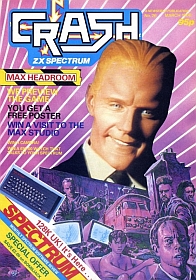
The March cover was, and still is, only the second CRASH cover to feature a photograph as it's main element (the first was Issue Six's, a photo of several assembled pieces of Oliver's artwork). Max Headroom had become something of a cult on TV, and for the subsidiary pictures Oliver drew on images from the specially-made feature film about how Max came into being. The trouble was that as Max was already a created image, Oliver thought painting him ran the danger of making him less than instantly recognisable, hence the photo.

Good software was still catching up with us in March, though Max Headroom had to wait another two months. There were seven Smashes and a lot of near misses. It had to be Mikro-Gen's month, two Smashes and Battle Of The Planets, which got 77%. Three Weeks In Paradise was yet another Wally Week extravaganza which showed that the formula had not quite worn thin yet, while Sir Fred was a fairy tale of damsels in distress and bold, rather well-animated, knights off to their rescue.
US Gold provided cold comfort with the excellent conversion of Winter Games - good enough to get over the multiload problem; Ocean scored with the unusual M.0.V.I.E. - forced perspective, icon control and a good detective story from a new Yugoslavian programmer of an unpronounceable name (later identified as Dusko Dimitrijevic); Mirrorsoft came up with one of the best flight simulations ever in Spitfire 40; and Derek fairly revelled in the conclusion of Level 9's Silicon Worm Trilogy, Worm In Paradise, and Melbourne House's long-awaited Lord Of The Rings.
Among the near misses was Design Design's Forbidden Planet, another ultrahigh-speed 3-D vector from their famous 'Basil' and Simon Brattell, but despite its playability we wondered whether it was different enough from Dark Star to warrant being Smashed. They also had a different type of game out: 2112 was an arcade-adventure in similar style to Dun Darach featuring a mechanoid dog called Poddy. Programmer Graham Stafford took the name from Jeremy Spencer's pet dog, which was often seen in the offices - it was nice to know that some Newsfield personnel appeared in games!
Licensed tie-ins were by now established. Rambo was a good example, Benny Hill's Madcap Chase by Don Priestley for DK'Tronics a rather odd one, Zorro from US Gold a somewhat poorer one, and hovering uneasily somewhere between the brilliant and the banal there was Quicksilva's Fred Flintstone tie-in Yabba Dabba Doo!.
On the Playing Tips pages, a new-look Robin Candy peered out. After several complaints in print, the Newsfield art department gave the playing tips a new page heading, and Robin's very outdated photo-graphic was replaced by an Oliver Frey drawing. Robin was pleased by the fact of a revamp, less thrilled by the picture; he wanted no picture at all. The argument became acrimonious, especially when Robin realised it was likely to be used on the following month's Playing Tips Supplement cover. In the end he agreed to the new heading with grave misgivings. It was a shame - though few people inside the company, and no readers, realised it at the time, the argument had caused a serious rift between Robin on one side and Roger Kean and Oliver Frey on the other. The rift was to grow wider...
Till this time software houses had usually put out games under their own name. I have already mentioned Electric Dreams being one of the first attached labels (to Activision), and now CRL - an often uneven producer of software and sometimes a company in search of an identity - launched a new side label called Nu Wave with I-D. I-D was to be the first of a series of new 'conundrum' games for people fed up of blasting and maze-walking. As Automata had found with Deus Ex Machina, however, CRL was to discover that the money really lay with blasting, and Nu Wave would disappear beneath the old attack waves.



